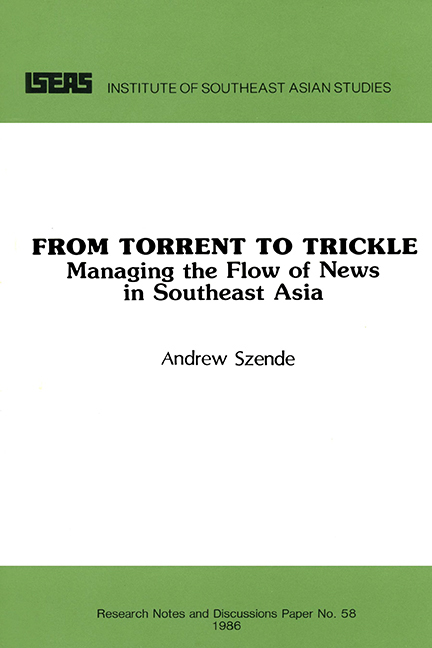Book contents
- Frontmatter
- Contents
- LIST OF TABLES
- Acknowledgements
- PART 1 INTRODUCTION
- PART 2 PERCEPTIONS
- IV The Dilemma of the ASEAN Exchange
- V News Samples in ASEAN
- VI Perceptions of Coverage in ASEAN
- VII Regional Coverage in ASEAN
- PART 3 CONCLUSION
- APPENDIX A
- APPENDIX B
- APPENDIX C
- APPENDIX D
- APPENDIX E
- APPENDIX F
- BIBLIOGRAPHY
- THE AUTHOR
VII - Regional Coverage in ASEAN
from PART 2 - PERCEPTIONS
Published online by Cambridge University Press: 21 October 2015
- Frontmatter
- Contents
- LIST OF TABLES
- Acknowledgements
- PART 1 INTRODUCTION
- PART 2 PERCEPTIONS
- IV The Dilemma of the ASEAN Exchange
- V News Samples in ASEAN
- VI Perceptions of Coverage in ASEAN
- VII Regional Coverage in ASEAN
- PART 3 CONCLUSION
- APPENDIX A
- APPENDIX B
- APPENDIX C
- APPENDIX D
- APPENDIX E
- APPENDIX F
- BIBLIOGRAPHY
- THE AUTHOR
Summary
As the evidence in Chapter VI demonstrated, the ASEAN news professionals tend not to be very satisfied with the way their region is being covered in the rest of the world, partly because they feel the world does not pay enough attention to the region and partly because they feel that the coverage tends to over-emphasize the negative aspects of their countries. However, by being less critical of the coverage of the rest of the world that reaches ASEAN, they seem to demonstrate that their news judgement is not entirely different from the western judgement, which dominates the world's news flow. This chapter examines how the ASEAN news professionals view the coverage of the region within the region. It also presents their judgements of the adequacy of the coverage provided by the various news sources. And, finally, it explores whether the similarities and differences in news values between the news professionals in the region and those in the rest of the world have any bearing on the ASEAN perceptions of the adequacy of their own news coverage.
The ASEAN press tend to cover their fellow ASEAN countries through six basic types of sources. First and foremost, the four international news agencies are available in all five countries of the region. Second, all ASEAN countries receive news from the ASEAN news agencies' news exchange. Third, a number of papers have bilateral “lifting rights” arrangements with other papers both inside and outside the region. Under these arrangements, a paper may reprint stories which first appeared in another paper. Such arrangements exist, for instance, between the New Straits Times and the Straits Times as well as between the Bangkok Post and the Straits Times. Fourth, at least one national news agency (Bernama) arid it least one newspaper (Straits Times) have their own correspondents in other ASEAN countries. Fifth, various editors in the region have their own informal arrangements with fellow editors and other sources, using their professional and personal contacts to obtain either full stories or information that can form part of a story.
- Type
- Chapter
- Information
- From Torrent to TrickleManaging the Flow of News in Southeast Asia, pp. 82 - 92Publisher: ISEAS–Yusof Ishak InstitutePrint publication year: 1986



